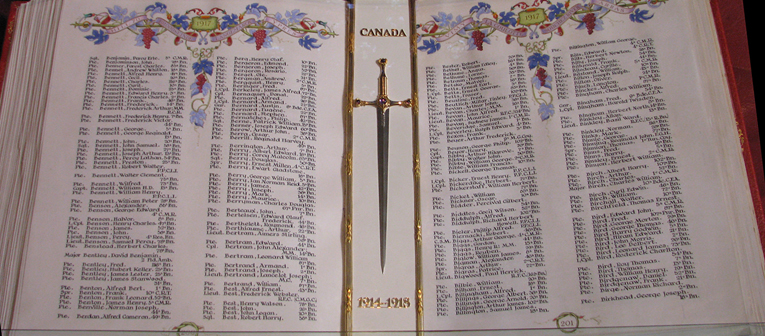
Thomas Froese
Some of the names of Canada’s war dead in one of Canada’s Books of Remembrance in the Peace Tower in Ottawa.
(The Hamilton Spectator – Saturday, November 18, 2023)
Speaking of war and death, here’s something.
Forty-five years ago today, on November 18, 1978, more than 900 people died in the Jonestown massacre. They were Americans in a Guyana settlement named after Jim Jones, a self-proclaimed prophet who’d been once lauded as an exceptional voice and humanitarian.
Jones’ followers, interested in good things like racial and civic harmony, like social and economic justice, followed their charismatic and deceptive leader to death. This is when the phrase, “Don’t drink the Kool-Aid,” that is don’t be duped, entered public lexicon. These people, in a different sort of war, literally drank cyanide-laced Kool-Aid. They took in a lie from hell.
I was barely a teen while watching the news that November day: bodies lying everywhere, looking like you or me or the neighbours, wearing jeans and shirts like they’re dressed for any ordinary day. More than 300 of them were younger than 18.
Two thoughts.
First, choose carefully who you follow. The world is full of liars. During times of upheaval and uncertainty, people are especially vulnerable to wonky thinking. Fear often leads us into it. And as the world changes, it’s easy to let fear get the better of you. So don’t.
Second thought. Anyone who’s half-curious or half-alive, even some kid who happens to be watching the news, will naturally wonder about what comes after death. At best we have a hazy sense, a faint light, of what might await. Sometimes that light might even come from a movie theatre. (Actor Leonardo DiCaprio, by the way, has signed to play Jim Jones in a movie now being developed about the Jonestown massacre.)
But it’s a different show, a documentary, “After Death,” that I recently saw in a local theatre that poked me about this age-old question of what’s after death. It explores so-called near-death experiences. They’ve dramatically increased in the 60 years since modern medicine has made it possible to sometimes resuscitate people who are clinically dead.
Consider “Evidence of the Afterlife: The Science of Near-Death Experiences,” by Dr. Jeffrey Long, a radiation oncologist who founded the Near-Death Experience Research Foundation. The foundation’s database now has about 5,000 names, people worldwide coming from various walks of life, all giving accounts of another dimension. They’re fascinating.
Sharing about out-of-body experiences, some tell doctors details of their lifesaving operations, otherwise impossible to know. They often speak of mysterious light (although sometimes of hellish darkness.) There’s often unconditional love, as if all the love of the universe has been lavished only on them. There’s deep peace, and colours and music so otherworldly that they’re indescribable. Some, as if in a celestial doorway, claim they’ve seen loved ones previously dead.
Think of leaving a two-dimensional, black-and-white painting to be awakened in a three-dimensional, colour room. The painting – “Do I have to return?” – is the earthly dream, while the room is revealed as eternal reality.
The point, though, is not to fixate on death. Or near-death. Or even what may follow death. It’s to be reminded that death, for all its sorrow – and brutality, especially in war – can also heighten our sense of life. Emily, in Thornton Wilder’s play, “Our Town,” from the other side and revisiting her twelfth birthday, put it this way. “Do any human beings ever realize life while they live it – every, every minute?”
Here’s something else, something to find in the Peace Tower in Ottawa’s Parliament Buildings. They’re our national Books of Remembrance. There are eight. Every day at 11 a.m. a constable turns a page in each book so all the names, about 118,000, of Canada’s war dead can be seen by the viewing public in any given year.
It need not be Remembrance Day. Or the Saturday after Remembrance Day. You can see them any day. That’s what pilgrimages are for, to remind us of what we value in life. So go and look sometime. It’s later when another book – the Book of Life – will put the mystery of death behind us.

Hi Thom,
Insightful as always! I find NDE’s fascinating on a number of levels. One is the convincing evidence of reports on versions of the afterlife. Another consists in the verifiable reports of what was happening in an operating room as viewed by the patient from somewhere outside their body. They make it difficult to argue that there is no “consciousness” separate from the body.
It’s true. The body has its limits in its consciousness. Which is why we’re told not to fear those who can destroy our body, but not our soul, but rather to fear our Maker, who has power over both.